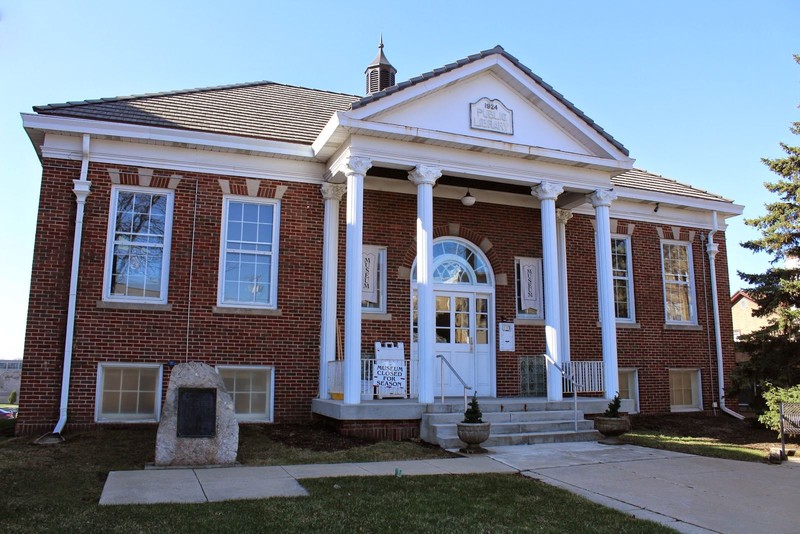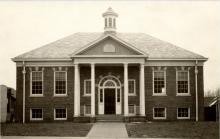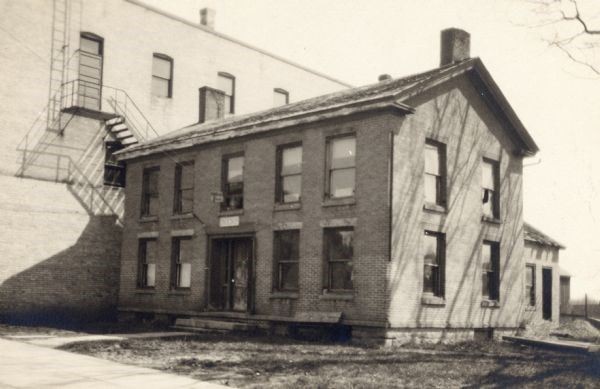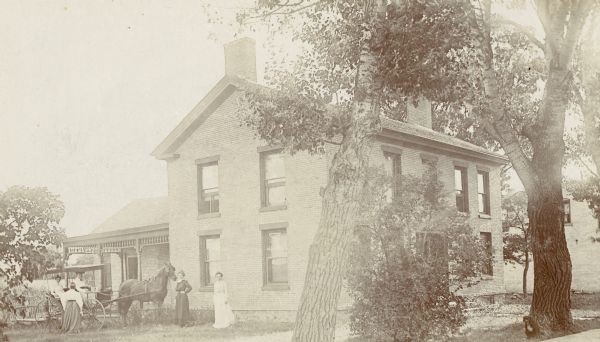Sun Prairie Historical Library and Museum
Introduction
Text-to-speech Audio
The Sun Prairie Historical Museum was founded on this site in 1969, dedicated to preserving and presenting the rich history of Sun Prairie as a frontier farming community to its recent acceleration as a growing residential city. Located in the center of Sun Prairie’s oldest district, the museum sits on the original homesite of Charles and Lovina Bird, who were the first pioneer settlers of the town in 1839 among the neighboring Ho-Chunk people. The museum’s current home is a 1924 red brick structure originally designed and used as the town’s library. Museum exhibits are changed frequently and focus on locally obtained artifacts and stories from the city’s 19th and 20th century inhabitants that introduce and place the observer into Sun Prairie’s past. A permanent exhibit contains information and memorabilia associated with renowned artist Georgia O’Keeffe, who was born in Sun Prairie in 1887 and spent her youth on the family farm south of the city.
Images
Museum-Library - Present View

Museum-Library Building - Circa 1925

Charles Bird House - 1922

Bird Home and Family

Backstory and Context
Text-to-speech Audio
The Sun Prairie Historical Museum’s collections link the current city to its pioneer beginning, one that starts with the legendary naming of the town itself. On December 3, 1836, the first Wisconsin Territorial legislature’s Act 11 established Madison – the “City of Four Lakes” – as the seat of government for the new Wisconsin territory. In accordance with the Act, commissioners Augustus A. Bird, James D. Doty and John F. O’Neill were elected to plan and execute the construction of government buildings in Madison. Of the three commissioners, Augustus Bird was appointed “acting commissioner,” responsible for the onsite decisions and direction of the construction team. On May 31, 1837, Augustus assembled a 36 person work party, including three women and his younger brother Charles H. Bird, that left Milwaukee to cross the 80 miles of wilderness separating them from the new Capitol location. (Note: Some references conflict on exact dates and total number in party.)
The team moved with three heavy ox carts that carried their tools and provisions, forging their own path on a westerly course. The group crossed the Rock River near the present site of Watertown and the Crawford River near the present site of Milford. Rain accompanied them continuously, creating wet ground that further slowed their movement and made the days and nights dreary and uncomfortable. On June 9, 1837, after days of dampness and plodding effort, the group emerged on the edge of what they described as a beautiful prairie, and at that instant the sun burst out of the clouds, casting the first rays of brightness and warmth they had seen on their journey. Joyfully moved by the moment, the group christened the site “Sun Prairie” and carved the name on a Burr Oak tree. The tree bearing the Sun Prairie inscription was said to have stood for many years approximately 1 ½ miles east of the namesake town center and Sun Prairie Historical Museum location, approximately ½ mile west of where Hwy VV crosses Hwy 19.
As a member of the capitol founding group, Charles H. Bird spent his first years in Wisconsin working with his brother on the construction of Madison and operating the “Madison Hotel.” After he met and married Lovina Brayton they chose to make their own home in the Sun Prairie area in 1839, at the junction of what later became the Watertown (now Hwy 19), Bristol (now Hwy N) and Columbus (now Hwy 151) roads – once known as Bird’s Corner. The Birds were the first settlers to reside in the area and built a wood framed home on the site – legend has it on the same spot that the capitol build team first camped when discovering and naming Sun Prairie. Visualizing the area as it existed when surveyed in 1840, an “oak opening” – described as a “park-like area studded with burr oaks, interspersed with occasional white or Black oaks that had escaped the frequent prairie fire flames, all carpeted with deep grass” – covered the hillside as it rose up to the current location of the Sun Prairie Water Tower. A small stream flowed from north to south by their home, passing Main St. where the Old City Hall is located. The stream drained from a small pond to the north down to the marsh that still exists below the current railroad tracks and behind Sun Prairie East High School. A group of Ho-Chunk people occupying wigwams near the current site of the Water Tower were the Birds' only neighbors when they first established their homestead.
Through the 1840s, as other settlers arrived, the Bird home became the social center of an emerging community that was formally organized as the town of Sun Prairie in 1846. In addition to farming, Charles was a merchant, the local Justice of the Peace and by the early 1850s had constructed a 2-story brick home on the site. Charles and Lovina had four sons prior to her death in 1852, all of whom served with Wisconsin regiments in the Civil War. Charles Bird would later remarry to Margaret Hayden and had a daughter, Ada, from that marriage. Ada Bird was an internationally acclaimed pianist and is credited with starting the School of Music at the University of Wisconsin.
Charles and Margaret continued to live in the house until Charles’ death in 1883, after which Margaret took up residence with Ada in Madison. When Ada passed unexpectedly in 1914, the house passed to her friend, Elizabeth Veerhusen Kind (Mrs. John Kind), who donated the house to the Village of Sun Prairie in 1923 with the purpose of making it a public library in memory of the Bird family. Upon close inspection, however, significant deterioration of the brick, hand-hewed pine underpinning and sills was found, and it was determined that renovating the existing structure would have been too costly an option to pursue. Consequently, with the consent of Mrs. Kind and members of the Bird family, the original house was razed and the current red brick building, designed by architect Alvan E. Small, was constructed as Sun Prairie’s first dedicated library building. Small was a native son to Sun Prairie, born in the village in 1869 and was locally renowned for designing “prairie-style” homes and larger buildings in Madison including the Randall School on Regent St. in Madison.
The new building served the community through the next decades and was a focal point for Sun Prairie’s Centennial Celebration held on September 5, 1937, with the dedication of the stone plaque that currently stands in front of the site honoring the original village founders. By 1969 however, the library had outgrown the available space and chose to relocate to a larger structure on the corner of N. Bird and Windsor Streets. Given the location’s historical significance, it was only fitting that the Sun Prairie Historical Museum adopted the building as its current home.
The Museum houses collections of local pioneer and 20th century artifacts and documents that are displayed on a rotating basis. The collections are also open for research activities associated with local history and genealogical investigation. The museum sponsors periodic tours of Sun Prairie’s historic downtown area and other events designed to provide stories and experiences through which people of all ages can better understand Sun Prairie’s past and appreciate how they are part of the community’s future.
Cite This Entry
Ron Tobia on behalf of Sun Prairie Historical Library and Museum and Director, Sun Prairie Historical Library and Museum. "Sun Prairie Historical Library and Museum ." Clio: Your Guide to History. July 21, 2024. Accessed April 22, 2025. https://theclio.com/entry/150268
Sources
History of Dane County, Wisconsin. Western Historical Company, 1880
https://content.wisconsinhistory.org/digital/collection/wch/id/69791
Klein, Peter Michael. Sun Prairie's People - Shadows and Dreams. Sun Prairie, WI. Sun Prairie Historical Museum, 1993.
Hayden, Estelle, and Nora Noyes Philpot, et.al. Early History of Sun Prairie, scrapbook by the (Sun Prairie) Twentieth Century Club, 1935.
Bridgeman, Michael. Alvan Small, Architect | Part 2: Designs for Education and Business. Madison Trust for Historic Preservation, August 31, 2021
https://www.madisonpreservation.org/blog/2021/8/31/alvan-small-architect-part-2-designs-for-education-and-business

